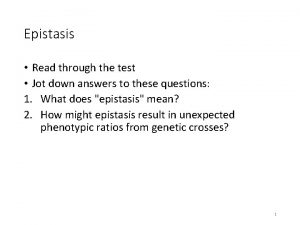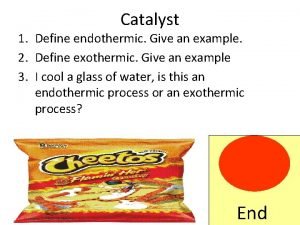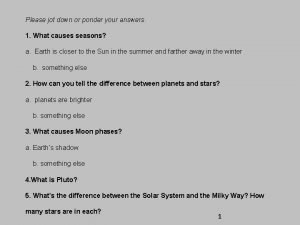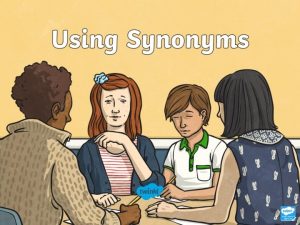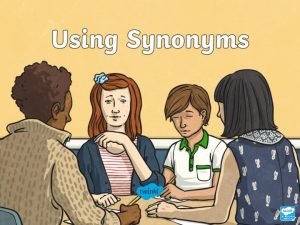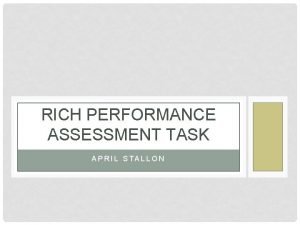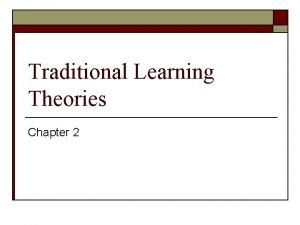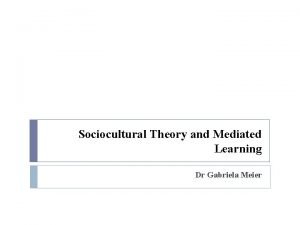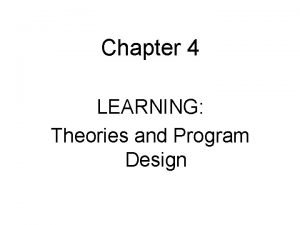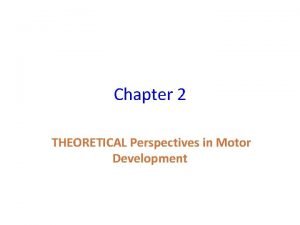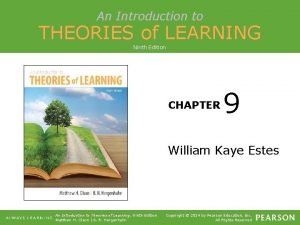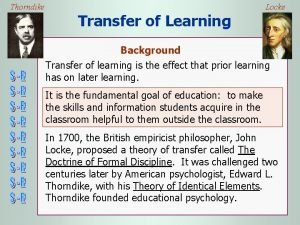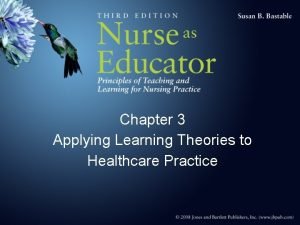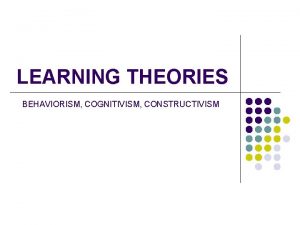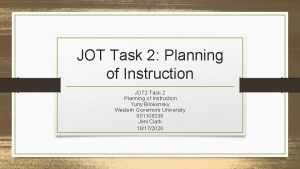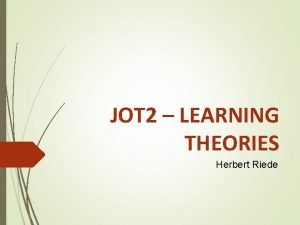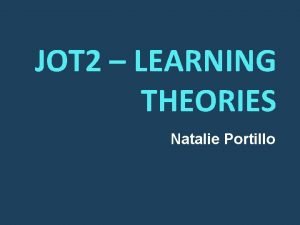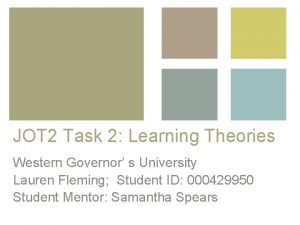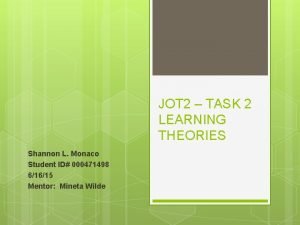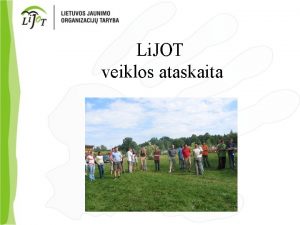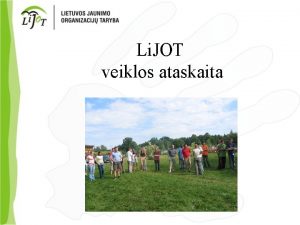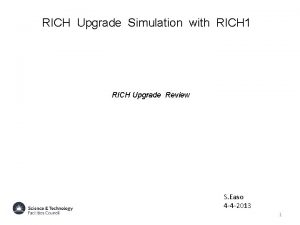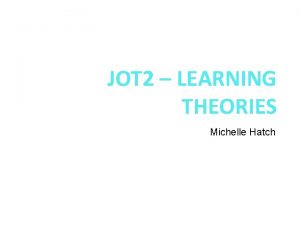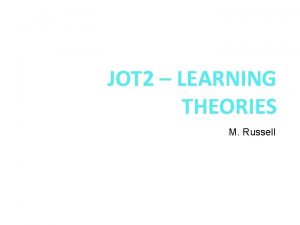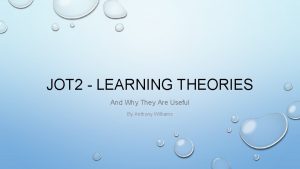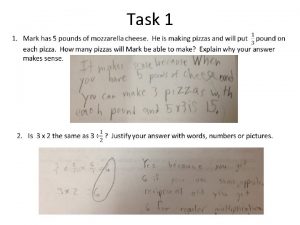JOT 2 LEARNING THEORIES Charles Rich Task A






















- Slides: 22

JOT 2 – LEARNING THEORIES Charles Rich

Task A: Learning Theories & Learners Constructivism, Cognitivism, Behaviorism “True teachers are those who use themselves as bridges over which they invite their students to cross; then, having facilitated their crossing, joyfully collapse, encouraging them to create their own. ” ― Nikos Kazantzakis

When Constructivism is Beneficial for Learners When learners need to build knowledge To solve a problem, or to construct collaboratively Best used to engage learner in “real world” contexts Used for the “big picture” stuff. Not as concerned with data as it is with ideas.

When Cognitivism is Beneficial for Learners When learners need to organize knowledge Best used when knowledge needs to be communicated or transferred to the student from a teacher or expert When learning and mastery styles are important When scaffolding is appropriate. Building knowledge on top of existing understanding.

When Behaviorism is Beneficial for Learners When learners need to acquire knowledge Best used to teach basic skills or foundational knowledge For tasks where rote memorization and recitation are needed When mastery of learning and behavioral competence in a scope and sequence is needed

Task B: Learning Theory Used in Lesson Plan M 303 Communication Activity 8. 1 Reading the IFR Supplement The current lesson includes a sample page from the IFR Supplement that is explained line-by-line in an included recorded lecture while students follow along and answer questions.

Learning Theory – Lesson Plan Language Objective: “This activity will develop your listening comprehension of technical lectures and familiarize you with the general content and organizational structure of the IFR Supplement. ” Primarily a cognitivist approach where a subject matter expert explains the reference material. Student listen to a lecture and answer questions from the workbook. The answers are given as a part of the lecture. The student is expected to understand the material and be able to use the supplement.

Task C: Adaptation of Lesson Plan A Constructivist Approach to The IFR Supplement Language Objective: This activity will familiarize you with the general content and organizational structure of the IFR Supplement. Scenario: You and your Instructor Pilot (IP) will be conducting a night flight to Randolph AFB. This type of mission requires flight under instrument flight rules and certain navigational aids, lighting, and information are required for this to be a safe flight.

What Else Changed? This lesson becomes a paired activity where two pilots look up the information in the supplement and discuss whether what they found meets the needs of their mission or if they need to know more. Following information gathering the class would discuss the importance of the information they found. This process helps to make the task more realistic and relevant. Our students won’t fall asleep during the forty minutes of lecture or complain about being bored.

Task D: Lesson Plan Discussion So what makes the cognitive approach to this lesson better? It’s more active. It’s “real world”. While pilots are expected to memorize emergency procedures and specifications in FOT, they are not expected to memorize the information from the IFR supplement. They are expected to be able to use it as a reference.

Task E: Effective Instruction Through the Use of Design Theories Why do we need to know design theories? Are they really relevant to my classroom? Someone else designs the lessons, right? Who thinks of this stuff?

Benefits of Using Design Theory Design theory helps to produce effective instruction. A design theory brings science to the table. Understanding design theory makes us better designers and teachers

Task F: Design Theories Strengths and Limitations: ● Wiggins Backward Design ● Gagne’s Nine Events of Instruction ● Teaching for Understand (The Harvard model)

Strengths of Wiggins Theory of Backward Design Emphasis on assessment throughout Frequent feedback is given and received Identifies desired results clearly Aligns with common core curriculum Determines validity of assessments

Limitations of Wiggins Assessment and data gained from it drive the instruction. Design of the assessment tools and collection of data can be quite labor intensive. The results of assessment drive further development which has to wait on the collection of data and analysis of results.

Strengths of Gagne’s Events Systematic approach that is easy to follow Great for new teachers Scaffolding builds on prior knowledge Provides modeling for observational learning Organized and structured learning objectives

Limitations of Gagne’s Events Rigid and leaves little room for creativity Teachers must break down and organize goals to fit Gagne’s established categories Learning objectives don’t always fit the categories The process is time consuming, especially the first time used

Strengths of Teaching for Understanding Integrates pre-existing knowledge Builds cognitive strategies Socially mediated learning (peer instruction) Constructive conversation builds speaking, listening, and negotiation skills

Weaknesses of Teaching for Understanding Requires students to have some knowledge of the content to begin with. Can be time consuming to prepare Not all learners have the skill to do it Requires non-traditional teaching styles

Task G: Most Suitable Design Process The most suitable design process for the Communication IFR Supplement Lesson Constructivism/Teaching for Understanding

Teaching for Understanding Encourages our students to participate in discussion Students learn at their own pace and learn as little or as much as needed to complete the task Students have access to more information if their peers know more Can be assessed through demonstration and observation

References Authentic Education - What is Ub. DTM? (n. d. ). Retrieved May 8, 2016, from http: //www. authenticeducation. org/ubd. lasso Ellen B. Meier, Ed. D. Understanding by Design. Retrieved May 8, 2016, from http: //edtech 4 schools. pbworks. com/f/Understanding%20 by%20 Desi gn%20 Teaching%20 Ellen%20 Meier%20 CTSC. pdf Defense Language Institute English Language Center. (2015). English Skills for Communication (Second, Vol. 2). Gagne, R. M. (1988). The events of instruction. In Principles of instructional design (pp. 185 -204). San Diego: Harcourt Brace College Publishers. Understanding by Design (n. d. ), Retrieved May 8, 2106, from https: //web 5. wgu. edu/aap/content/introduction%20 to%20 ubd. pdf What is Teaching for Understanding? (n. d. ). Retrieved May 8, 2016, from http: //www. gse. harvard. edu/news/uk/08/05/what-teachingunderstanding
 Jot air balloon
Jot air balloon Jot osp wymagania
Jot osp wymagania Jot down questions
Jot down questions Define endothermic
Define endothermic Please jot down
Please jot down Similar images
Similar images Jot down synonym
Jot down synonym Concept learning task in machine learning
Concept learning task in machine learning Rich performance assessment task
Rich performance assessment task Charles manson charles luther manson
Charles manson charles luther manson Tiered task bias task
Tiered task bias task Cuadro comparativo e-learning m-learning b-learning
Cuadro comparativo e-learning m-learning b-learning Traditional learning theories
Traditional learning theories Scaffolding theory bruner
Scaffolding theory bruner Learning theories and program design
Learning theories and program design Motor development theories
Motor development theories Cognitive learning theory
Cognitive learning theory An introduction to theories of learning
An introduction to theories of learning Thorndike learning theory
Thorndike learning theory Learning theories related to health care practice
Learning theories related to health care practice Differentiated learning theories
Differentiated learning theories Constructivism vs behaviorism
Constructivism vs behaviorism Learning task 2 im an architect
Learning task 2 im an architect


